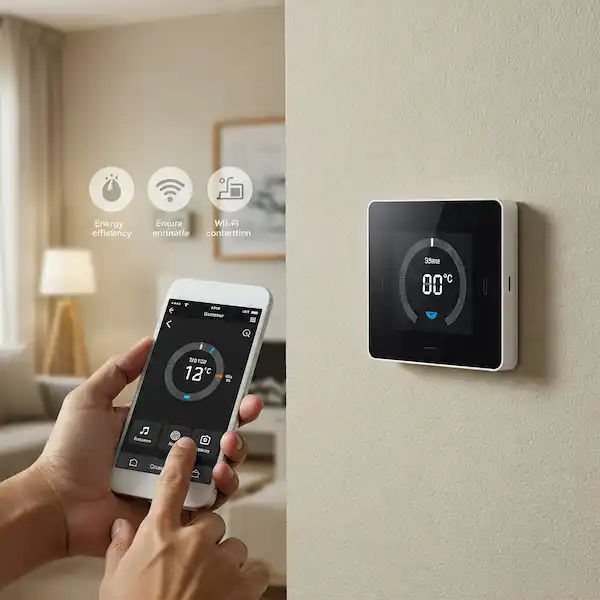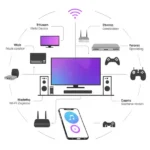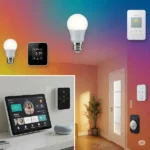Take Control of Your Comfort and Energy Bills: A Guide to Smart Thermostats
In today’s world, where energy efficiency and home comfort are paramount, smart thermostats are revolutionizing how we manage our indoor climates. More than just a simple temperature control, these connected devices offer advanced features that can lead to significant energy savings, enhanced convenience, and a more comfortable living environment.
What is a Smart Thermostat?
Unlike traditional manual or programmable thermostats, a smart thermostat connects to your home’s Wi-Fi network, allowing you to control your heating and cooling system remotely via a smartphone app, tablet, or computer. Many models also incorporate learning algorithms, sensors, and integrate with other smart home devices to optimize your home’s climate automatically.
The Benefits of Going Smart
Switching to a smart thermostat offers a range of advantages:
- Energy Savings: This is often the primary motivator. Smart thermostats can learn your habits, adjust temperatures when you’re away or asleep, and utilize features like geofencing (using your phone’s location to know if you’re home) to reduce energy waste. Some models provide detailed energy usage reports, helping you identify areas for further savings. ENERGY STAR certified smart thermostats are independently verified to deliver energy savings.
- Enhanced Comfort: Smart thermostats can maintain consistent temperatures based on your preferences and schedule. Features like room sensors can help balance temperatures across different areas of your home, eliminating hot or cold spots.
- Convenience and Remote Control: Adjust your home’s temperature from anywhere using your smartphone. Forgot to turn down the heat before leaving for vacation? No problem. Stuck in traffic and want the house to be comfortable when you arrive? Easy. Many also integrate with voice assistants like Alexa, Google Assistant, and Siri for hands-free control.
- Maintenance Alerts: Some smart thermostats can monitor your HVAC system’s performance and send reminders for routine maintenance, such as changing air filters, which can help extend the life of your equipment.
- Environmental Impact: By reducing energy consumption, smart thermostats contribute to a smaller carbon footprint, making your home more eco-friendly.
- Integration with Smart Home Ecosystems: Smart thermostats can work seamlessly with other smart devices, creating automated routines for a more integrated and convenient home.
Pros and Cons to Consider
While the benefits are compelling, it’s important to consider both the pros and cons:
Pros:
- Significant potential for energy savings and lower utility bills.
- Convenient remote access and control via smartphone apps.
- Learning capabilities adapt to your schedule and preferences automatically.
- Features like geofencing and occupancy sensors enhance efficiency.
- Can provide valuable insights into energy usage.
- Integration with voice assistants and other smart home devices.
- Maintenance reminders for your HVAC system.
Cons:
- Higher upfront cost compared to traditional or basic programmable thermostats.
- May require a “C” wire for power, which might necessitate professional installation if your current wiring doesn’t include one (though some models offer workarounds or power adapters).
- Requires a stable Wi-Fi connection to utilize smart features.
- Learning curve for users unfamiliar with smart home technology or app interfaces.
- Potential privacy concerns as the devices collect data about your home’s occupancy and temperature preferences (though reputable brands employ security measures).
- Not compatible with all HVAC systems, particularly older or more complex ones.
Examples of Popular Smart Thermostats
The smart thermostat market offers a variety of options with different features and price points. Some well-known examples include:
- Google Nest Learning Thermostat: Known for its learning capabilities, sleek design, and integration with the Google Home ecosystem.
- Ecobee Smart Thermostat Premium: Often praised for its included remote sensor to help balance temperatures in different rooms, built-in voice assistant, and air quality monitor.
- Honeywell Home T9 Smart Thermostat: Features a touch screen display and the option to add multiple room sensors for enhanced zonal control.
- Amazon Smart Thermostat: A more budget-friendly option that integrates seamlessly with Amazon Alexa.
- Emerson Sensi Smart Thermostats: Offer a range of models with varying features, often known for their user-friendly app and compatibility with multiple smart home platforms.
Best Use Scenarios
Smart thermostats are particularly well-suited for:
- Homes with variable schedules: If your daily routine is unpredictable, features like geofencing can automatically adjust the temperature based on whether you’re home or away, ensuring comfort and saving energy without manual programming.
- Individuals seeking maximum energy savings: The advanced optimization features and energy reporting can help those motivated to reduce their energy consumption and lower bills.
- Users who value convenience and remote access: Being able to control your home’s temperature from anywhere provides unparalleled flexibility.
- Smart home enthusiasts: Smart thermostats are a key component of a connected home, integrating with lighting, security, and other devices for automated routines.
- Homes with temperature imbalances: Utilizing remote sensors can help address rooms that are consistently too hot or too cold.
By understanding the capabilities and considerations of smart thermostats, you can make an informed decision about whether this technology is the right fit for your home, leading to greater comfort, control, and potentially significant savings on your energy bills.
Additional helpful information
Here is more information about how to set up a smart home – How to Set Up a Smart Home?
More details about a Smart HVAC System – Smart HVAC Systems: Revolutionizing Home Comfort




